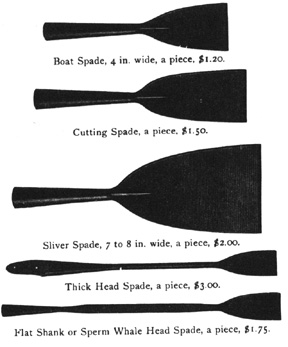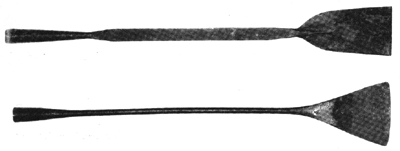 Whalecraft
Whaling
Whalesite
Whalecraft
Whaling
Whalesite


Spades were used primarily for cutting up a whale. They were flat-bladed implements (except the gouge spade) with a chisel cutting edge and were mounted on wood poles by means of a socket at the aft end of the spade. The blades of later spades, after the 1850's, were usually made of cast steel, while the sockets and shanks were wrought iron. Cast steel held a cutting edge far better than the earlier wrought iron, and was necessary for repeated cutting. The sockets of spades were forge welded closed, without an open seam, for added strength. They were secured to the pole with a nail, screw or pin
The different types of whaling spades are (click on one to go directly to it):
Boat Spades Cutting-in Spades Sliver Spades Throat Spades Head Spades Gouge Spades
Boat Spades 
Thick Boat Spade Blade is 3-1/2" wide, 7" long, 5/8" thick, sharpened all three edges The first cut made on a whale was made with a spade carried in the whaleboat, and therefore was called a boat spade. There were two types of boat spades - thick and thin. The thick boat spade was the earlier one and was the only spade designed for use in the capture of a whale. Its heavy, 5/8" thick blade was sharpened on the two side edges as well as the front chisel edge. It was used to stop a running whale after it was harpooned. This was known as "spading flukes" and was done by wielding the heavy spade like an axe to cut the tendons in the whale's small, at the base of its tail, thereby stopping the whale's mobility. This was an extremely dangerous operation. As the whale threw its flukes high in the air, just before diving, the whaleboat was directed in under the upraised tail and the officer of the boat quickly cut as many tendons in the small as possible. Spading flukes required great skill and courage, and it was not attempted in the later years of whaling. James T. Brown writing in The Whale Fishery in 1887 confirmed this:
Spading flukes is one of the lost arts of the fishery, and may never again be revived, but will live with the whalemen from generation to generation.
After the whale was killed by the lance, the boat spade was used for cutting holes in the body. The line for towing the carcass to the whaleship was fastened through the holes.

Thin Boat spade Blade is 3-1/8" wide, 6-1/2" long, 1/8" thick Note short warp rigged to pole When spading flukes went out of practice weight was not needed for the boat spade and so the thick boat spade was replaced by the thin boat spade, used in the whaleboat only for cutting holes in the carcass for towing. The thin boat spade was also used on the whaleship for removing blubber from the whale. When used in this way it was called a narrow cutting spade, to distinguish it from the usual cutting spade with a slightly wider blade. The cutting spade had a blade four to five inches wide, while the narrow cutting spade was no more than four inches wide.
Back to top of the page Back to Spades menu
Cutting Spades
The process of cutting up a whale and removing the blubber and baleen (whalebone) was called cutting in, and was accomplished by the use of several types of spades, each intended for a specific function. When cutting in, the officers using the spades were positioned on a stage, or planks, rigged above the whale that was tied alongside the starboard side of the whaleship, flukes forward. The earliest form of cutting stage was merely a spruce plank twelve inches wide suspended over the the side of the vessel by ropes The plank was positioned forward of the gangway on one end and aft of it on the other. The lengths of the planks varied with the size of the whaleship. This simple type of cutting stage was replaced by the outrigger stage about the time of the Civil War, although they were sometimes used in addition to the outrigger stage after that time. The outrigger stage was an eighteen inch wide plank about twenty feet long braced out from the side of the whaleship by boards about ten feet long, either tied or bolted to the ends of the stage. The officers stood on
Cutting in, ca 1905 Note outrigger planks and safety ropes

Cutting spades Blade is 4-7/8" wide, 9-1/4" long, 1/8" thick Length including pole is 12' 9" the cutting stage facing the whaleship to cut the whale lying between the stage and the vessel. For safety a rope was suspended on iron poles about three feet high along the inboard length of the stage. The entire outrigger was suspended by tackle from davits or from the mast, and was hoisted up vertically when not in use.
The spades used from the cutting stage were mounted on extremely long spruce poles, approximately twenty feet long to span the distance from the stage to the carcass below. The cutting spades were pinned through their sockets to the poles to prevent loss The blubber was cut into a long spiral strip about six feet wide called a blanket As the blanket was hoisted up, by means of a huge iron blubber hook and tackle rigged from the mast to the windlass, peeling more of the blubber off, the whale was rolled over in the water. The line of cuts made by the

Method of cutting in a sperm whale From The Marine Mammals of the North-western Coast of North America and The American Whale Fishery, by Charles M Scammon cutting spades was called the scarf, and the process was known as scarfing. The scarf that was cut to define the width of the blanket was made by successive thrusts of the narrow cutting spade. A narrow spade was used because blubber was difficult to cut and a wide spade, making a longer cut at each thrust, would have encountered more resistance and would therefore not cut deep enough. Each cut was made at an angle to the previous cut so that the scarf was not a straight line, but a slightly zigzag line. To ensure a continuous scarf, it was easier to intersect two angled cuts than to connect two in-line cuts.

Cutting spade ground with a leaning edge Blade is 4-1/8" wide, 6-1/4" long, 1/8" thick The wider cutting spades were used to cut free the flesh adhering to the blubber and binding it to the carcass while the blanket was being raised. This was called leaning up. Cutting spades were often ground with a pronounced curvature to the cutting edge, called a leaning edge. During the cutting-in process, the spades became dull, or were boned, that is struck bone and were chipped or dulled. This kept the grinding wheel turning, sharpening spades almost continuously.
Back to top of the page Back to Spades menu
Sliver Spades 

Top: Sliver spade Blade is 7-5/8" wide, 13-1/2" long, 3/16" thick, overall length is 21" bottom: Sliver spade on short pole for use in blubber room Blade is 8" wide, 9-1/2" long, 3/16" thick, overall length is 19-1/2", overall length including pole is 56" The broadest of all spades was the sliver spade, which had a blade six to eight inches wide It was used primarily in decapitating a whale during the cutting-in process. The sliver spade severed the pieces of blubber and flesh, called slivers, connecting the head and body of the whale. It was also sometimes used as a blubber room spade to cut the blanket pieces, which were severed lengths of the blanket about fourteen feet long, into smaller pieces called horse pieces, about six feet long - the width of the blanket piece - and about one foot wide. (These horse pieces were then taken to the mincing horse on deck for mincing prior to boiling). When intended for use in the blubber room, sliver spades were mounted on short poles. When used for decapitating a whale, they were mounted on long cutting-spade poles.
Back to top of the page Back to Spades menu
Throat, or Bone Spades 
Flat shank throat spade (top) and round shank throat spade (bottom) Flat shank spade blade is 4" wide, 8" long, 3/16" thick, overall length is 40-3/8" Round shank spade blade is 6-3/8" wide, 8-3/4" long, 1/8" thick overall length is 36-3/4" There were two types of throat spades: flat-shank and round-shank. They were also called bone spades. Both types were used to cut long passages in the head for securing the head strap or throat chain, and both were used to remove the baleen, or bone (thus bone spade) from baleen whales. Their long shanks were made of soft wrought iron so they would bend easily while cutting long passages around jaw bones and would not break due to the motion of the carcass in the water while the spade was lodged deep in the head. The flat shank was a rectangular cross section, about 1" to 1-1/4" wide by 3/8" thick. The round shank was about 5/8" diameter. Bone spades, or throat spades, were approximately three feet long overall. There was no difference functionally between the round shank and the flat shank. Note, however, that in the advertisement by Frank E. Brown at the top of this page, he calls the last spade a "Flat Shank or Sperm Whale Head Spade".
Back to top of the page Back to Spades menu
Head Spades 
Head spade Blade is 3-5/8" wide, 10" long, 7/16" thick, shank is 1" diameter Overall length is 40-3/4" The heaviest spade was the head spade, often sharpened on three edges and used by the captain or first mate to cut through bones when decapitating a whale. The great weight was needed to add momentum to the thrust to help chop the large bones. The edges were sharpened as well as the chisel end so the spade could be wielded like an axe. The blades were at least a half inch thick and the shanks were about one inch in diameter. Overall, the head spades were three to four feet long, and they were mounted to heavy poles. The sockets of these spades were frequently made with an extension sleeve on one side to add support to the pole; two or three holes were provided in the extension for screwing or pinning the spade to the pole.
Back to top of the page Back to Spades menu
Gouge Spades 
Gouge spade, or half-round spade Blade has a pronounced cylindrical curve, rather than a flat blade Curve is 1-1/2" deep, 3-3/4" across, blade is 3/16" thick, 10" long, shank is 11/16" thick, overall length is 20-3/4" A gouge spade, or half-round spade, was used to cut holes in the blubber for attaching the blubber hook or blubber toggle for hoisting the blanket. According to James T. Brown in The Whale Fishery and Its Appliances, Washington, Government Printing Office, 1883:
The half-round spade is used by sperm-whalemen for making a large hole in the blubber for the blubber-hook. It is also used, though seldom, from the waist of the vessel, for making holes in the blanket-piece which are used in fastening the blubber to the cutting-tackle.
The blade of the gouge spade was semi-cylindrical, so that only two cuts were needed to make a round hole. This seems like an unecessary expense for such a specialty spade. Holes in the blanket piece were normally made with narrow cutting spades or with boarding knives. Gouge spades were rarely used.
©: 2000 - 2008 Thomas G Lytle . All rights reserved
Back to top of the page Back to Spades menu Back to top of this page
